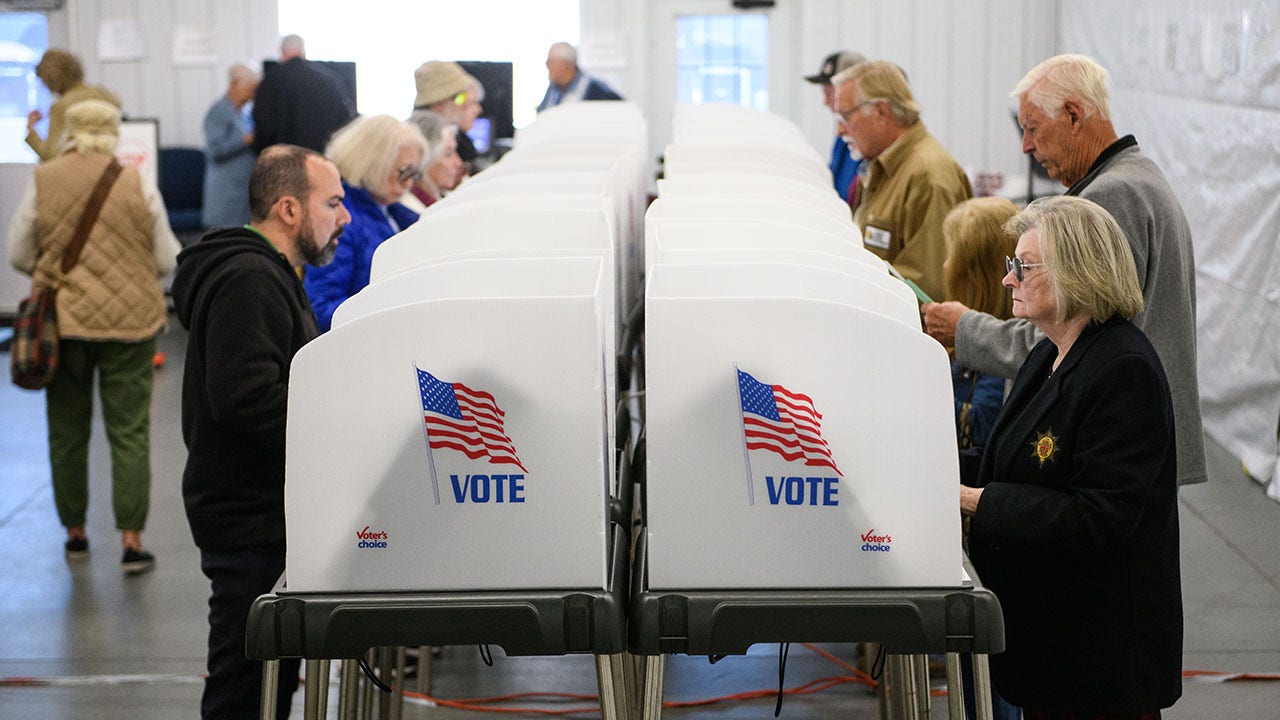Oregon
Winter road maintenance will continue with $19 million promise from Kotek, Oregon Legislature – Oregon Capital Chronicle

Oregon’s top elected officials pledged to spend millions of dollars on winter road maintenance after dire warnings from the state Department of Transportation that highways would go unplowed because of a budget shortfall.
Gov. Tina Kotek, Senate President Rob Wagner and House Speaker Dan Rayfield announced Monday that the state would commit $19 million to make up the shortfall and allow the department to buy snow plows, purchase sand and salt for deicing roads and fix potholes and damaged pavement next spring.
“It’s critical that all Oregonians have a safe, reliable transportation system to get to work, school, and play,” said Rayfield, D-Corvallis. “Thanks to the work our transportation and budget leaders have invested to understand the safety and functional needs of our communities, we are able to ensure a safe winter season and ultimately, a more sustainable, equitable system.”
The announcement follows the first serious snowfall of the season. Major ski areas, including Timberline Lodge on Mount Hood and Mount Bachelor near Bend, opened temporarily this weekend, but warmer weather and heavy rain washed away much of the snow. More snow is expected in mountain passes this weekend.
The state transportation department warned in October that it would cut back on road maintenance, including plowing some roads once a day or less instead of four times a day. Agency leaders cited looming budget shortfalls caused by decreases in gas tax revenue tied to Oregonians driving more fuel-efficient vehicles or driving less.
The department can begin using the money now, and it will be officially approved by the Legislature in the 2024 session.
Kotek said in a statement she plans to find long-term solutions to ensure highways meet the needs of Oregon residents, businesses and visitors. The Legislature will work on a major transportation funding package in the 2025 legislative session.
“In the meantime, I greatly appreciate Senate President Wagner and House Speaker Rayfield for prioritizing this funding now so that Oregonians can have safer road conditions this winter,” Kotek said.
The $19 million commitment includes $8 million for buying materials like deicer and salt and lifting the agency’s restriction on overtime. That would allow staff to work longer hours during storms and their aftermath.
Another $4 million would go toward replacing 10 trucks primarily used for snow plowing. The department has approximately 400 trucks, many of which are beyond service life. The new trucks will be on the road by next winter because it takes a long time to order and purchase them.
The final $7 million would be used mostly for spring repairs to roads damaged by winter freeze cycles. The agency will get $4.5 million to patch pavement and fix potholes throughout the state and $2.5 million to retrace edge lines on highways with 3,000 or fewer daily drivers next spring.
“Whether it’s July or January, Oregonians need to be able to travel safely on our highways,” said Wagner, D-Lake Oswego. “This commitment from myself and Speaker Rayfield — in coordination with our budget co-chairs — guarantees critical funding to keep Oregonians safe throughout the year.”
GET THE MORNING HEADLINES DELIVERED TO YOUR INBOX

Oregon
Oregon housing budget would fund shelters, slash eviction prevention

FILE – Rapid Response Bio-Clean teams perform removals of homeless camps in Portland’s Old Town Chinatown, March 9, 2025. Through the House Bill 5011, the Oregon Housing and Community Services Department would see its two-year budget cut by a range from $1 billion to more than $2.6 billion starting July 1, 2025.
Kristyna Wentz-Graff / OPB
Oregon lawmakers have unveiled a budget bill that would continue to funnel vast sums of money toward homeless shelters statewide while slashing funds for preventing evictions.
Democrats advanced the bill through a legislative subcommittee on a 5-2 party-line vote Tuesday, sending it to leaders on the Joint Committee on Ways and Means, who write the state’s budget.
Under Gov. Tina Kotek, Oregon has invested billions of dollars toward housing and homelessness in recent years, but the state continues to struggle with rising homelessness, evictions and a shortage of affordable housing.
Now, through House Bill 5011, the state’s Housing and Community Services Department would see its two-year budget reduced by roughly $1 billion to more than $2.6 billion starting July 1.
“The state has fewer resources than was anticipated when the Governor released her recommended budget in December, and she has appreciated that legislators have difficult decisions to make,” Roxy Mayer, Kotek’s press secretary, said in a statement Wednesday.
Funds to prevent eviction would see the biggest hit. The latest budget bill allocates $33.6 million toward programs like rental assistance or legal services that intend to keep Oregonians from becoming homeless in the first place.
That’s almost $100 million less than what was allocated in the current budget. For the upcoming biennium, Kotek had asked for $173.2 million to keep those programs running.
The latest budget proposal has enough money to serve about 4,300 households facing eviction, compared to more than 27,700 in the budget lawmakers passed in 2023, according to the nonprofit Oregon Law Center.
Oregon’s housing crisis persists. Here’s what lawmakers are doing about it
The budget would also allocate $50.3 million toward helping Oregonians transition from homelessness to stable housing (Kotek had asked for $188.2 million), and $87.4 million for long-term rental assistance (Kotek’s request: $105.2 million). The governor is reviewing the budget, Mayer said.
“The Governor expects to be disappointed and hopes there will be additional investments in homelessness and housing in the end-of-session bill,” said Mayer.
The bill comes as the Legislature has $500 million less in revenue than formerly predicted for the state’s next budget, largely due to ongoing trade tensions and slow economic growth.
With only a few weeks left in this year’s legislative session, lawmakers are weighing a variety of competing priorities, such as Kotek’s proposal to dedicate hundreds of millions of dollars toward Oregon’s education and behavioral health systems.
In a statement Tuesday night, Democrats described the bill as “an ambitious plan to expand affordable housing, reduce homelessness, and protect vulnerable families.”
“This budget should serve as a clear sign to all Oregonians that housing remains a statewide priority, even amid federal uncertainty and economic strain,” Sen. Mark Meek, D-Gladstone, the co-chair of the Subcommittee on Transportation and Economic Development, which advanced the budget.
“We’ve made real progress, but we know that we must continue building on the work we’ve done until we solve this crisis.”
But on Tuesday, some committee members voiced concern that the state has been too slow to dole out funds through its housing programs — including for wildfire survivors — and they say regulations have stymied housing production.
“It feels like we should be seeing a lot more results for the dollars we’re investing, and I think there is ongoing frustration with Oregonians that we aren’t,” said Rep. Jami Cate, R-Lebanon, who voted against advancing the bill out of committee. “It seems that often the problem is growing.”
The bill comes as eviction filings last year surged to record highs — 27,290 cases total — and homelessness increased. Meanwhile, local governments issued fewer housing permits for the second consecutive year, falling to the lowest level in 12 years.
Rep. David Gomberg, D-Otis, co-chair of the Subcommittee on Transportation and Economic Development, said Tuesday that he pressed the state housing department for progress updates in recent months.
“The answer we’ve consistently received is that there was a big program and it took them a while to stand it up and to begin to get things moving.
“So I’m looking forward to success,” he said. “I also want to note that the budget we’re approving today is a far cry from what was requested by the governor.”
Oregon governor’s $217M homeless shelter bill faces uncertain future as budget woes mount
Housing and tenant advocates fear that backing off investments for eviction prevention could propel more people into homelessness, as many Oregonians face a shortage of housing and costs that have exceeded their wages.
“We understand that it’s a tough budget environment,” Sybil Hebb, the director of legislative advocacy for the Oregon Law Center, told OPB Wednesday. “But I think we were shocked and really devastated to see the proposed severity of the cuts.”
Hebb says that investing in eviction prevention is the best way to decrease costs on the social safety net by keeping people from being trapped in the cycle of homelessness.
“People are living very close to the bone these days, and housing is extremely expensive,” said Hebb.
She added: “Any unexpected expense or unplanned illness can put people temporarily upside down. These are dollars and resources and services that help people through that immediate crisis to make sure that it doesn’t turn into a long term.”
Despite recent concerns that the state might step back its role in funding shelters, the budget would allocate nearly $205 million to support homeless and emergency shelters. Kotek had asked for more than $217 million.
“Shelter dollars in the bill will help our local partners keep their doors open and beds available,” Rep. Pam Marsh, D-Ashland, chair of the House Committee on Housing and Homelessness, said in a statement Wednesday.
“That’s essential, because our shelters are the entry point to the continuum of services that enable individuals to regain stability and find permanent housing.”
The budget would also dedicate $10 million toward housing programs for Oregon’s nine federally recognized tribes.
Oregon
Power shutoffs banned during extreme summer heat in Oregon

The Oregon Public Utility Commission has approved temporary rules to protect low-income residential customers from power disconnections during high summer heat.
The ban starts this month and runs through October and is meant to ensure Oregonians – including those who rely on medical devices – can safely cope with extreme temperatures. The protections stem from a bill passed in 2021, dubbed the Energy Affordability Act, which required the commission to adopt measures to reduce the burden of high electricity costs for Oregonians.
Under the new rules, all investor-owned electric utilities – Portland General Electric, PacifiCorp and Idaho Power – are prohibited from disconnecting service due to non-payment during major heat waves.
The rules apply when the National Weather Service or another local jurisdiction issues a heat advisory or extreme heat watch or warning or when a local air quality alert is issued.
Customers also are protected in the 24 hours before a qualifying hot spell and in the 48 hours after. They’re also protected 24 hours after an air quality alert has been issued.
Customers whose utility services were disconnected up to seven days before a heat event can request to be reconnected without delay once the extreme weather begins.
Typically, utilities can charge a reconnection fee and require customers to pay at least a portion of their past due bills before reconnecting them. But the new rules waive upfront reconnection fees for medical certificate account holders and discount program participants earning less than 10% of state median income. (Once the heat wave is over, customers are still responsible for paying their past due bills and reconnection fees).
The new rules also require utilities to inform customers about the protections so they can quickly get service reconnected.
The commission is poised to adopt permanent rules by the end of next year.
Customer advocates hailed the rules in the wake of the state’s first high heat event earlier this week.
“This past weekend, we saw record-breaking heat that threatened the health and safety of our seniors, neighbors with disabilities, and families. These new protections mean that no one will be left at home in danger without electricity simply because their energy bills are too expensive,” said Charlotte Shuff, a spokesperson for the Oregon Citizens’ Utility Board, a nonprofit organization that advocates for utility customers and supported the measures.
— Gosia Wozniacka covers environmental justice, climate change, the clean energy transition and other environmental issues. Reach her at gwozniacka@oregonian.com or 971-421-3154.
Oregon
Could Trump deploy Oregon National Guard if immigration protests escalate?

PORTLAND Ore. (KPTV) – If protests break out in Oregon in response to federal immigration raids, President Donald Trump could legally mobilize the state’s National Guard, like he has done recently in Los Angeles.
Federal law grants the president authority to federalize a state’s National Guard under Title 10 of the U.S. Code, Section 12406, in situations of “insurrection, invasion, or rebellion,” or when it becomes “impracticable” to enforce federal law by regular means. In such a scenario, Guard troops are placed under federal control, though their roles would be largely restricted to protecting federal personnel or property. They would not be allowed to arrest civilians due to the Posse Comitatus Act, which prohibits the use of federal military forces in domestic law enforcement.
This means, that if Trump evoked this authority during immigration-related unrest, Oregon’s Guard troops could not act as police officers.
The president also has access to the Insurrection Act, a more sweeping statue that allows deployment of active-duty military or federalized Guard troops without a governor’s consent.
While this law has rarely been used, it could theoretically be used if civil disorder severely threatened federal operations.
There have been ICE protests in Portland recently, but they have been largely peaceful.
On Monday, during a press conference, Gov. Tina Kotek indicated she would push back against any such actions.
She described Guard troops being federalized in California as, “an alarming disregard for the safety of Americans and their ability to govern themselves.”
“The president’s unlawful actions undermine our local authorities, who should be able to do their jobs without a federal intervention escalating and inflaming the situation,” said Kotek.
So, Trump has the authority, but his power is limited for how Guard troops can enforce the law. Any attempt to deploy the Guard to quell protests would also likely be met with lawsuits from the state of Oregon.
Copyright 2025 KPTV-KPDX. All rights reserved.
-

 West5 days ago
West5 days agoBattle over Space Command HQ location heats up as lawmakers press new Air Force secretary
-

 Alaska1 week ago
Alaska1 week agoInterior Plans to Rescind Drilling Ban in Alaska’s National Petroleum Reserve
-

 Education1 week ago
Education1 week agoVideo: Inside Trump’s Attack on Harvard
-

 Technology1 week ago
Technology1 week agoMicrosoft will finally stop bugging Windows users about Edge — but only in Europe
-

 Politics1 week ago
Politics1 week agoRed state tops annual Heritage Foundation scorecard for strongest election integrity: 'Hard to cheat'
-

 World1 week ago
World1 week agoTwo suspected Ugandan rebels killed in Kampala explosion
-

 News1 week ago
News1 week agoVideo: Man Arrested After Attack on Supporters of Israeli Hostages
-

 Politics1 week ago
Politics1 week agoTrump pushes 'Big, Beautiful Bill' as solution to four years of Biden failures: 'Largest tax cut, EVER'



















